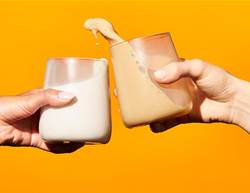Peanut butter can be a nutritious part of a balanced diet. However, added sugar, salt and unhealthy oils may make some versions of it more of a junk food. Not to mention, people with peanut or nut allergies may have to avoid it altogether. And while you may still enjoy other nut butter options, you may be wondering if you can still make space for the beloved spread in your pantry. So, we asked experts: is peanut butter healthy?
Whole30 and Paleo diets bundle peanuts into the legume family alongside peas, beans and lentils, because peanuts are legumes botanically and not a tree nut. These diets recommend cutting out legumes but allow for tree nuts to be enjoyed during meal and snack times. Because of this popular diet framework, shoppers might leave peanut butter behind to opt for tree-nut butter like almond, cashew and hazelnut instead.
“Those diets are fads, plain and simple,” says dietitian Lauren Harris-Pincus. “To me, any diet that cuts out whole food groups is a fad.” She notes, short of a peanut allergy or intolerance, there’s no real reason to remove entire food groups like legumes from your diet. Any controversy over peanut butter is likely due to a lot of misinformation about the classic spread, adds dietitian Wesley Delbridge.
So, is peanut butter healthy? Or is the beloved sandwich spread not doing you any favours? Here, experts explain the health benefits of eating peanut butter as well as the risks of eating too much of it.
Peanut butter nutrition facts
According to the USDA, two tablespoons of smooth peanut butter with salt contains approximately:
- Calories: 191 (800kJ)
- Total fat: 16g
- Sodium: 137mg
- Total carbohydrates: 7g
- Fibre: 1.5g
- Sugar: 3g
- Protein: 7g
Compared to other nut butter varieties, peanut butter has a slightly different micronutrient profile, but is generally similar in nutritional value, says dietitian Jessica Zinn. Depending on the specific brand you pick up, peanut butter may be slightly more nutritious compared to other nut varieties with a touch more protein, vitamins and minerals, Harris-Pincus adds.
Be sure to check the ingredient list of the container you’re buying, Delbridge notes. If you’re looking to watch your sugar or sodium intake, you may want to consider purchasing a natural peanut butter made from just roasted peanuts. This will usually appear with a layer of oil at the top you need to mix in because natural options don’t include an emulsifier to keep everything together.
Delbridge suggests using half-natural and half of your favourite sweetened peanut butter at first to help acclimate your palate to the less sweet flavour of natural peanut butter. And if you really prefer the sweetness of classic peanut butter, he says that’s totally okay as long as you consider the sugar and kilojoules in your overall daily goals.
Peanut butter health benefits
Peanut butter has a lot of benefits to boast about. It’s a good source of protein, monounsaturated fats, fibre, and many vitamins and minerals like phosphorus, potassium and niacin, says dietitian Melissa Prest. Peanut butter is also shelf-stable, can be easily transported, is versatile in recipes, has a long expiration date and kids love it, Delbridge says.
And if the high-fat content concerns you, Zinn assures that it actually works in your favour. “The high-fat content promotes satiety and satisfaction with meals,” she says. This also makes peanut butter great for someone trying to lose weight, because the fat and protein content will keep you full for longer, Prest adds. Plus, it has no cholesterol and has a higher ratio of healthy fat to saturated fat, she notes.
Peanut butter can fit into many different diets. Zinn says that those who keep an eye on their blood sugar can benefit from peanut butter because it’s low in carbohydrates and has a low glycemic index, so it has a very small effect on blood sugar. “This can be a great addition to a snack or meal that will promote blood sugar balance,” she notes.
Additionally, peanut butter is far cheaper than its competitors. “People have this halo around almond butter instead of peanut butter, but it’s far more expensive and we get elitist about our food,” Harris-Pincus says. But, of course, there are benefits to a wide variety of foods in your diet. If your taste preferences and budget allow, feel free to mix and match with all different kinds of nut butter, she notes.
If that’s not enough, peanuts are also far more sustainable than many other nuts, Harris-Pincus says. They grow with far less water, using around 18 litres of water per 28 grams of peanuts compared to 300 litres of water per 28 grams of almonds. Plus, they have the smallest carbon footprint in comparison, she adds.
Potential risks of peanut butter
The main reason peanuts and other legumes are cut from many popularised diets is that legumes contain lectins, proteins that bind with carbohydrates and are present in most plants, Delbridge explains. Popular media and fad diets have associated lectins with obesity, chronic inflammation and autoimmune diseases, according to Harvard School of Public Health.
These lectins are designed to protect the legume and have received the reputation of being the “anti-nutrient” because they prevent some vitamins from being absorbed and occasionally cause stomach discomfort, he says. Additionally, peanuts may contain phytates, which can bind to some minerals like zinc and iron and may impair absorption, Zinn adds.
But Delbridge says it’s not necessarily something to be concerned about. This really only applies when someone consumes very large amounts of legumes, which far surpasses the recommended serving size.
“Peanut butter’s recommended portion size is so small, it’s not going to affect your digestion or absorption of nutrients in any significant way,” Delbridge says. But, of course, if you find that legumes are giving you some stomach upset, you can make the personal decision to avoid them, he notes.
How much peanut butter should you be eating?
“Since peanut butter is rich in kilojoules and fat, although they are heart-healthy fats, consuming it in excess can lead to weight gain,” Zinn warns.
The recommended serving size for a meal or a snack of peanut butter is about two tablespoons, which contains about 190 calories (800kJ) and about 3.5 grams of saturated fats, or 16% of the daily recommendation. Prest advises to keep your peanut butter intake to no more than two tablespoons a day, but this can be overdone very easily. Zinn suggests using a measuring spoon or food scale to ensure you’re getting the correct amount.
“I am a firm believer there is no such thing as a bad food in a healthy diet, there are just unhealthy portions,” Delbridge says. He adds that as long as you’re considering the food you’re eating throughout the day with the goal of balance, peanut butter is totally healthy to consume every day. Try some of our expert-approved peanut butter options.









